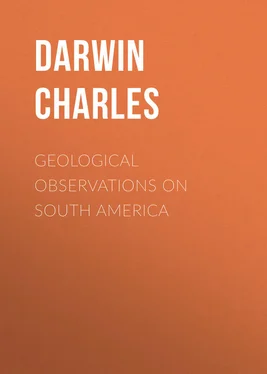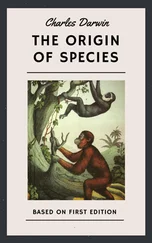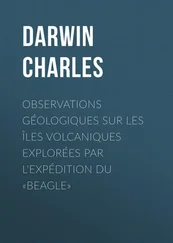Charles Darwin - Geological Observations on South America
Здесь есть возможность читать онлайн «Charles Darwin - Geological Observations on South America» — ознакомительный отрывок электронной книги совершенно бесплатно, а после прочтения отрывка купить полную версию. В некоторых случаях можно слушать аудио, скачать через торрент в формате fb2 и присутствует краткое содержание. Жанр: foreign_antique, foreign_prose, на английском языке. Описание произведения, (предисловие) а так же отзывы посетителей доступны на портале библиотеки ЛибКат.
- Название:Geological Observations on South America
- Автор:
- Жанр:
- Год:неизвестен
- ISBN:нет данных
- Рейтинг книги:3 / 5. Голосов: 1
-
Избранное:Добавить в избранное
- Отзывы:
-
Ваша оценка:
- 60
- 1
- 2
- 3
- 4
- 5
Geological Observations on South America: краткое содержание, описание и аннотация
Предлагаем к чтению аннотацию, описание, краткое содержание или предисловие (зависит от того, что написал сам автор книги «Geological Observations on South America»). Если вы не нашли необходимую информацию о книге — напишите в комментариях, мы постараемся отыскать её.
Geological Observations on South America — читать онлайн ознакомительный отрывок
Ниже представлен текст книги, разбитый по страницам. Система сохранения места последней прочитанной страницы, позволяет с удобством читать онлайн бесплатно книгу «Geological Observations on South America», без необходимости каждый раз заново искать на чём Вы остановились. Поставьте закладку, и сможете в любой момент перейти на страницу, на которой закончили чтение.
Интервал:
Закладка:
Darwin's study of the older tertiary formations, with their abundant shells, and their relics of vegetable life buried under great sheets of basalt, led him to consider carefully the question of climate during these earlier periods. In opposition to prevalent views on this subject, Darwin points out that his observations are opposed to the conclusion that a higher temperature prevailed universally over the globe during early geological periods. He argues that "the causes which gave to the older tertiary productions of the quite temperate zones of Europe a tropical character, WERE OF A LOCAL CHARACTER AND DID NOT AFFECT THE WHOLE GLOBE." In this, as in many similar instances, we see the beneficial influence of extensive travel in freeing Darwin's mind from prevailing prejudices. It was this widening of experience which rendered him so especially qualified to deal with the great problem of the origin of species, and in doing so to emancipate himself from ideas which were received with unquestioning faith by geologists whose studies had been circumscribed within the limits of Western Europe.
In the Cordilleras of Northern and Central Chili, Darwin, when studying still older formations, clearly recognised that they contain an admixture of the forms of life, which in Europe are distinctive of the Cretaceous and Jurassic periods respectively. He was thus led to conclude that the classification of geological periods, which fairly well expresses the facts that had been discovered in the areas where the science was first studied, is no longer capable of being applied when we come to the study of widely distant regions. This important conclusion led up to the further generalisation that each great geological period has exhibited a geographical distribution of the forms of animal and vegetable life, comparable to that which prevails in the existing fauna and flora. To those who are familiar with the extent to which the doctrine of universal formations has affected geological thought and speculation, both long before and since the time that Darwin wrote, the importance of this new standpoint to which he was able to attain will be sufficiently apparent. Like the idea of the extreme imperfection of the Geological Record, the doctrine of LOCAL geological formations is found permeating and moulding all the palaeontological reasonings of his great work.
In one of Darwin's letters, written while he was in South America, there is a passage we have already quoted, in which he expresses his inability to decide between the rival claims upon his attention of "the old crystalline group of rocks," and "the softer fossiliferous beds" respectively. The sixth chapter of the work before us, entitled "Plutonic and Metamorphic Rocks – Cleavage and Foliation," contains a brief summary of a series of observations and reasonings upon these crystalline rocks, which are, we believe, calculated to effect a revolution in geological science, and – though their value and importance have long been overlooked – are likely to entitle Darwin in the future to a position among geologists, scarcely, if at all, inferior to that which he already occupies among biologists.
Darwin's studies of the great rock-masses of the Andes convinced him of the close relations between the granitic or Plutonic rocks, and those which were undoubtedly poured forth as lavas. Upon his return, he set to work, with the aid of Professor Miller, to make a careful study of the minerals composing the granites and those which occur in the lavas, and he was able to show that in all essential respects they are identical. He was further able to prove that there is a complete gradation between the highly crystalline or granitic rock-masses, and those containing more or less glassy matter between their crystals, which constitute ordinary lavas. The importance of this conclusion will be realised when we remember that it was then the common creed of geologists – and still continues to be so on the Continent – that all highly crystalline rocks are of great geological antiquity, and that the igneous ejections which have taken place since the beginning of the tertiary periods differ essentially, in their composition, their structure, and their mode of occurrence, from those which have made their appearance at earlier periods of the world's history.
Very completely have the conclusions of Darwin upon these subjects been justified by recent researches. In England, the United States, and Italy, examples of the gradual passage of rocks of truly granitic structure into ordinary lavas have been described, and the reality of the transition has been demonstrated by the most careful studies with the microscope. Recent researches carried on in South America by Professor Stelzner, have also shown the existence of a class of highly crystalline rocks – the "Andengranites" – which combine in themselves many of the characteristics which were once thought to be distinctive of the so-called Plutonic and volcanic rocks. No one familiar with recent geological literature – even in Germany and France, where the old views concerning the distinction of igneous products of different ages have been most stoutly maintained – can fail to recognise the fact that the principles contended for by Darwin bid fair at no distant period to win universal acceptance among geologists all over the globe.
Still more important are the conclusions at which Darwin arrived with respect to the origin of the schists and gneisses which cover so large an area in South America.
Carefully noting, by the aid of his compass and clinometer, at every point which he visited, the direction and amount of inclination of the parallel divisions in these rocks, he was led to a very important generalisation – namely, that over very wide areas the direction (strike) of the planes of cleavage in slates, and of foliation in schists and gneisses, remained constant, though the amount of their inclination (dip) often varied within wide limits. Further than this it appeared that there was always a close correspondence between the strike of the cleavage and foliation and the direction of the great axes along which elevation had taken place in the district.
In Tierra del Fuego, Darwin found striking evidence that the cleavage intersecting great masses of slate-rocks was quite independent of their original stratification, and could often, indeed, be seen cutting across it at right angles. He was also able to verify Sedgwick's observation that, in some slates, glossy surfaces on the planes of cleavage arise from the development of new minerals, chlorite, epidote or mica, and that in this way a complete graduation from slates to true schists may be traced.
Darwin further showed that in highly schistose rocks, the folia bend around and encircle any foreign bodies in the mass, and that in some cases they exhibit the most tortuous forms and complicated puckerings. He clearly saw that in all cases the forces by which these striking phenomena must have been produced were persistent over wide areas, and were connected with the great movements by which the rocks had been upheaved and folded.
That the distinct folia of quartz, feldspar, mica, and other minerals composing the metamorphic schists could not have been separately deposited as sediment was strongly insisted upon by Darwin; and in doing so he opposed the view generally prevalent among geologists at that time. He was thus driven to the conclusion that foliation, like cleavage, is not an original, but a superinduced structure in rock-masses, and that it is the result of re-crystallisation, under the controlling influence of great pressure, of the materials of which the rock was composed.
In studying the lavas of Ascension, as we have already seen, Darwin was led to recognise the circumstance that, when igneous rocks are subjected to great differential movements during the period of their consolidation, they acquire a foliated structure, closely analogous to that of the crystalline schists. Like his predecessor in this field of inquiry, Mr. Poulett Scrope, Charles Darwin seems to have been greatly impressed by these facts, and he argued from them that the rocks exhibiting the foliated structure must have been in a state of plasticity, like that of a cooling mass of lava. At that time the suggestive experiments of Tresca, Daubree, and others, showing that solid masses under the influence of enormous pressure become actually plastic, had not been published. Had Darwin been aware of these facts he would have seen that it was not necessary to assume a state of imperfect solidity in rock-masses in order to account for their having yielded to pressure and tension, and, in doing so, acquiring the new characters which distinguish the crystalline schists.
Читать дальшеИнтервал:
Закладка:
Похожие книги на «Geological Observations on South America»
Представляем Вашему вниманию похожие книги на «Geological Observations on South America» списком для выбора. Мы отобрали схожую по названию и смыслу литературу в надежде предоставить читателям больше вариантов отыскать новые, интересные, ещё непрочитанные произведения.
Обсуждение, отзывы о книге «Geological Observations on South America» и просто собственные мнения читателей. Оставьте ваши комментарии, напишите, что Вы думаете о произведении, его смысле или главных героях. Укажите что конкретно понравилось, а что нет, и почему Вы так считаете.












